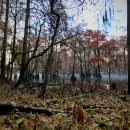About Us
Tensas River National Wildlife Refuge was established in 1980 “For the preservation and development of the environmental resources ... to conserve the diversity of fish and wildlife and their habitat ... for the conservation and development of wildlife and natural resources, the development of outdoor recreation opportunities, and interpretative education,” and “to give special consideration to management of the timber on the refuge to insure continued commercial production and harvest compatible with the purposes for which the refuge is established and the needs of fish and wildlife which depend upon the dynamic and diversified hardwood forest” (94 Stat. 595, dated June 28, 1980);
The bottomland hardwood forests of the Refuge contain a diversity of plant and animal species. Over 400 species of mammals, birds, reptiles, amphibians, and fish can be found on the refuge. Today, the refuge consists of nearly 80,000 acres of bottomland hardwood forests and oxbow lakes. This type of habitat once covered 25 million acres of the Mississippi Alluvial Valley. Today, the state's largest population of the Louisiana black bear lives throughout the refuge alongside healthy populations of white-tailed deer, American alligators, and other native wildlife species. The last sighting of the ivory-billed woodpecker, which is thought to be extinct by most scientists, occurred in the 1940's adjacent to what is now the Tensas River National Wildlife Refuge.
Other Facilities in this Complex
Tensas River NWR is part of the North Louisiana Refuges Complex. The Complex Headquarters is located at D'Arbonne National Wildlife Refuge.



